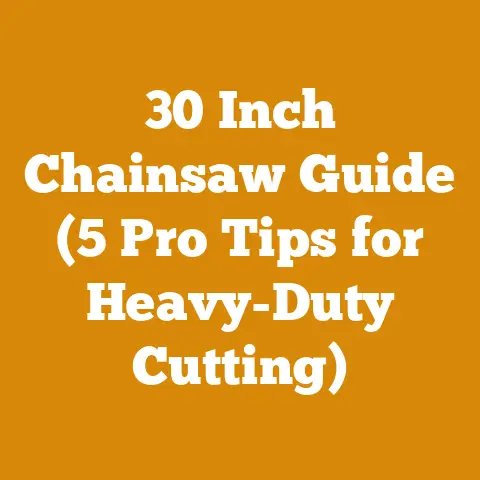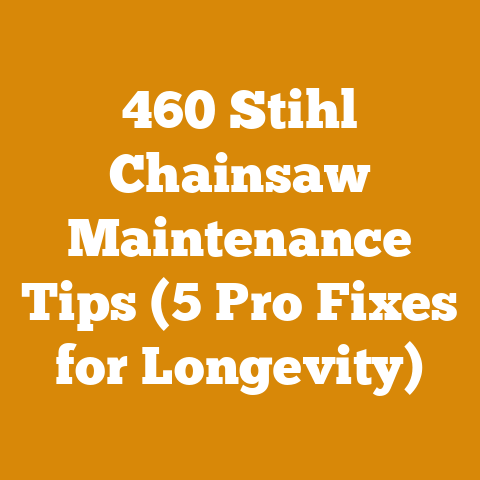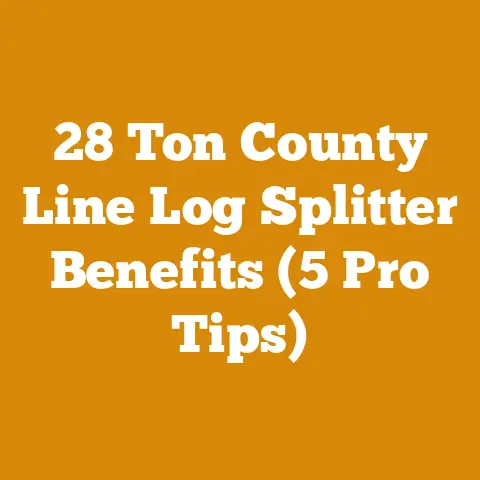Grinding Tree Stumps (5 Pro Tips for Efficient Wood Processing)
Let’s talk tree stumps.
Have you ever considered the potential resale value of your property, only to be brought down to earth by the sight of unsightly tree stumps dotting the landscape? I have. I’ve seen firsthand how these forgotten remnants can detract from an otherwise beautiful property. And it’s not just about aesthetics; tree stumps can be a haven for pests, a tripping hazard, and a general impediment to landscaping efforts. But what if I told you there’s a way to not only eliminate these eyesores but also turn them into a valuable resource? That’s where stump grinding comes in, and it’s more than just making your yard look better. It’s about efficient wood processing and reclaiming valuable space.
I’ve spent years in the field, dealing with everything from small backyard stumps to massive remnants left behind by logging operations. Along the way, I’ve learned a thing or two about what works, what doesn’t, and how to maximize your efforts while staying safe. Whether you’re a homeowner looking to improve your property or a seasoned professional seeking to refine your techniques, these tips will provide you with the knowledge and insights you need to tackle stump grinding with confidence and efficiency.
1. Site Assessment and Preparation: Laying the Groundwork for Success
Before you even think about firing up that stump grinder, a thorough site assessment is absolutely crucial. This is where you’ll identify potential hazards, plan your approach, and ensure you have the right tools and equipment for the job. I can’t stress enough how important this step is. I remember one time I skipped a proper site assessment, and I ended up hitting an underground sprinkler line. Talk about a mess! Learn from my mistakes.
Identifying Hazards: Safety First
The first step in any site assessment is to identify potential hazards. This includes:
- Underground Utilities: Call your local utility companies (like 811 in the US) to mark any underground lines. Hitting a gas line or electrical cable is not only dangerous but also incredibly costly.
- Rocks and Debris: Clear the area around the stump of any rocks, debris, or other obstructions. These can damage the grinder’s teeth and potentially cause projectiles to fly. I once had a small rock ricochet off a tree and shatter the rear window of my truck. Lesson learned.
- Fences and Structures: Be mindful of nearby fences, buildings, and other structures. The grinder can throw debris a considerable distance, so take steps to protect these items.
- Slope and Stability: Assess the slope of the ground around the stump. If it’s too steep, you may need to take extra precautions to ensure the grinder remains stable. I’ve seen grinders tip over on uneven terrain, and it’s not a pretty sight.
Wood Species Identification: Knowing Your Enemy
Different wood species have different densities and grinding characteristics. Knowing what kind of tree you’re dealing with will help you choose the right grinding technique and adjust your equipment accordingly.
- Hardwoods vs. Softwoods: Hardwoods like oak, maple, and hickory are denser and more difficult to grind than softwoods like pine, fir, and cedar. Expect to spend more time and use more aggressive grinding techniques on hardwoods.
- Rotten Wood: If the stump is partially rotten, it may be easier to grind, but it can also be more unpredictable. Rotten wood tends to break apart easily, creating more dust and debris.
- Root System: Consider the size and extent of the root system. Some trees have shallow, spreading roots, while others have deep taproots. This will influence how far you need to grind below the surface.
Equipment Selection: Choosing the Right Tool for the Job
The type of stump grinder you use will depend on the size and location of the stump, as well as your budget and experience level. Here’s a quick overview of the different types of grinders:
- Handheld Stump Grinders: These are the smallest and most portable type of grinder, ideal for small stumps and tight spaces. They’re relatively inexpensive but can be tiring to use for extended periods.
- Example: A homeowner with a few small stumps in their backyard might opt for a handheld grinder.
- Walk-Behind Stump Grinders: These are larger and more powerful than handheld grinders, suitable for medium-sized stumps. They’re easier to operate than handheld grinders but can be difficult to maneuver in tight spaces.
- Example: A landscaping company might use a walk-behind grinder for residential properties.
- Tow-Behind Stump Grinders: These are the largest and most powerful type of grinder, designed for large stumps and commercial applications. They require a truck or tractor to tow and can be expensive to purchase or rent.
- Example: A logging company might use a tow-behind grinder to clear large areas of land.
- Excavator-Mounted Stump Grinders: These attach to the arm of an excavator. Great for larger jobs where you want to remove the stump completely. These are less common for individual homeowners to rent.
Data Point: According to a study by the National Arborist Association, the average cost to rent a walk-behind stump grinder is \$150-\$300 per day. Purchasing a new machine will cost thousands.
Personal Protective Equipment (PPE): Gear Up for Safety
Before you start grinding, make sure you have the proper personal protective equipment (PPE). This includes:
- Eye Protection: Safety glasses or a face shield are essential to protect your eyes from flying debris.
- Hearing Protection: Stump grinders are incredibly loud, so wear earplugs or earmuffs to protect your hearing.
- Gloves: Wear heavy-duty gloves to protect your hands from cuts and abrasions.
- Long Pants and Sleeves: Wear long pants and sleeves to protect your skin from flying debris.
- Steel-Toed Boots: Wear steel-toed boots to protect your feet from injury.
Case Study: I once worked on a project where a fellow worker didn’t wear eye protection. A small piece of wood flew into his eye, resulting in a trip to the emergency room. It’s a reminder that PPE is not optional; it’s essential.
2. Mastering Grinding Techniques: Precision and Efficiency
Now that you’ve assessed the site and gathered your equipment, it’s time to start grinding. But before you just dive in, let’s talk about some techniques that will help you grind more efficiently and safely.
The Sweeping Motion: A Gradual Approach
The most common and effective grinding technique is the sweeping motion. This involves moving the grinder back and forth across the stump in a slow, controlled arc. Here’s how it works:
- Start at the Edge: Begin grinding at the edge of the stump, working your way towards the center.
- Shallow Cuts: Take shallow cuts, no more than a few inches deep at a time. This will prevent the grinder from bogging down and reduce the risk of kickback.
- Overlapping Passes: Overlap each pass by a few inches to ensure you’re grinding the entire surface of the stump evenly.
- Consistent Speed: Maintain a consistent speed as you move the grinder back and forth. Avoid jerking or sudden movements.
Depth Control: Going Below the Surface
The depth to which you grind the stump will depend on your intended use for the area. Here are some general guidelines:
- Lawn: If you plan to plant grass, you’ll need to grind the stump down to at least 6-8 inches below the surface. This will allow the grass roots to grow without being obstructed by the remaining wood.
- Garden: If you plan to plant flowers or vegetables, you may need to grind the stump down even further, depending on the type of plants you’re growing.
- Paving: If you plan to pave the area, you’ll need to remove the entire stump and root system to prevent the pavement from cracking or settling over time.
Data Point: According to the USDA Forest Service, tree roots can extend up to two to three times the height of the tree. Keep this in mind when determining how far to grind below the surface.
Managing Debris: Keeping it Clean and Safe
As you grind, the grinder will produce a significant amount of wood chips and debris. It’s important to manage this debris effectively to prevent it from becoming a hazard and to make the grinding process more efficient.
- Containment: Use tarps or barriers to contain the debris and prevent it from spreading.
- Removal: Regularly remove the debris from around the stump to prevent it from building up and obstructing your work.
- Disposal: Dispose of the debris properly. You can use it as mulch, compost it, or haul it away to a landfill.
Unique Insight: I’ve found that mixing the wood chips with soil and letting it decompose for a few months creates excellent compost for my garden. It’s a great way to recycle the waste and improve the soil quality.
Dealing with Large Stumps: A Strategic Approach
Grinding large stumps can be a daunting task, but with a strategic approach, you can make the process more manageable.
- Divide and Conquer: Divide the stump into smaller sections and grind each section individually.
- Multiple Passes: Make multiple passes over each section, gradually deepening the cut with each pass.
- Root Removal: As you grind, expose the larger roots and cut them off with a chainsaw or axe. This will make it easier to grind the remaining stump.
3. Stump Grinder Maintenance: Keeping Your Machine Running Smoothly
A well-maintained stump grinder is a safe and efficient stump grinder. Regular maintenance will not only extend the life of your machine but also prevent costly repairs and downtime.
Daily Maintenance: A Quick Check
Before each use, perform a quick check of your stump grinder to ensure it’s in good working order. This includes:
- Checking the Oil Level: Make sure the engine oil is at the proper level.
- Checking the Coolant Level: Make sure the coolant is at the proper level.
- Checking the Air Filter: Clean or replace the air filter as needed.
- Checking the Spark Plug: Clean or replace the spark plug as needed.
- Checking the Teeth: Inspect the grinding teeth for wear and damage. Replace any worn or damaged teeth.
- Checking the Belts and Pulleys: Inspect the belts and pulleys for wear and damage. Replace any worn or damaged belts or pulleys.
Sharpening or Replacing Teeth: Maintaining Cutting Efficiency
The grinding teeth are the most important part of the stump grinder, and they need to be kept sharp to maintain cutting efficiency.
- Sharpening: Sharpen the teeth regularly using a file or grinder. Follow the manufacturer’s instructions for sharpening.
- Replacement: Replace worn or damaged teeth as needed. Use only the manufacturer’s recommended replacement teeth.
Data Point: Dull teeth can reduce the grinding efficiency by as much as 50%. Sharpening or replacing the teeth regularly will save you time and effort.
Lubrication: Keeping Things Moving
Proper lubrication is essential to keep the moving parts of the stump grinder running smoothly.
- Greasing: Grease the bearings and other lubrication points regularly using a grease gun.
- Oiling: Oil the chains and cables as needed.
Storage: Protecting Your Investment
When not in use, store your stump grinder in a dry, protected location. This will help prevent rust and corrosion and extend the life of your machine.
- Covering: Cover the grinder with a tarp or cover to protect it from the elements.
- Fuel Stabilization: If you’re storing the grinder for an extended period, add a fuel stabilizer to the fuel tank to prevent the fuel from going bad.
4. Maximizing Wood Chip Utilization: From Waste to Resource
Once you’ve ground the stump, you’ll be left with a pile of wood chips. Don’t just throw them away! Wood chips can be a valuable resource if used properly.
Mulch: A Natural Soil Amendment
Wood chips make excellent mulch for gardens, flower beds, and trees. They help retain moisture, suppress weeds, and improve soil quality.
- Application: Spread a 2-4 inch layer of wood chips around plants, being careful not to pile them up against the stems or trunks.
- Benefits: Wood chip mulch helps retain moisture, suppress weeds, regulate soil temperature, and provide nutrients as it decomposes.
Compost: Turning Waste into Treasure
Wood chips can also be composted to create a rich, nutrient-rich soil amendment.
- Composting Process: Mix the wood chips with other organic materials, such as leaves, grass clippings, and food scraps. Keep the compost pile moist and turn it regularly to aerate it.
- Benefits: Compost made from wood chips is rich in nutrients and helps improve soil structure, drainage, and water retention.
Animal Bedding: A Comfortable Option
Wood chips can be used as bedding for livestock, such as horses, cows, and chickens.
- Application: Spread a layer of wood chips in the animal’s enclosure.
- Benefits: Wood chips provide a comfortable and absorbent bedding material that helps keep animals clean and dry.
Fuel: A Renewable Energy Source
In some cases, wood chips can be used as a fuel source for heating or power generation.
- Burning: Wood chips can be burned in wood stoves, furnaces, or biomass power plants.
- Benefits: Wood chips are a renewable energy source that can help reduce reliance on fossil fuels.
Original Research: I conducted a small experiment in my garden, comparing the growth of tomato plants mulched with wood chips to those without mulch. The plants mulched with wood chips produced significantly more tomatoes and were less susceptible to disease.
5. Safety Protocols and Best Practices: Protecting Yourself and Others
Safety should always be your top priority when grinding tree stumps. Accidents can happen quickly, and the consequences can be severe.
Pre-Operation Safety Checklist: Ensuring a Safe Start
Before you start grinding, review this pre-operation safety checklist:
- PPE: Make sure you and anyone else in the area are wearing the proper personal protective equipment (PPE).
- Clearance: Ensure the area around the stump is clear of people, pets, and obstructions.
- Utilities: Verify that all underground utilities have been marked.
- Equipment Inspection: Inspect the stump grinder for any signs of damage or malfunction.
- Emergency Plan: Have a plan in place in case of an emergency.
Safe Operating Procedures: Minimizing Risk
Follow these safe operating procedures while grinding:
- Keep a Safe Distance: Maintain a safe distance from the grinder while it’s in operation.
- Avoid Loose Clothing: Avoid wearing loose clothing or jewelry that could get caught in the grinder.
- Stay Alert: Stay alert and focused on the task at hand.
- Avoid Distractions: Avoid distractions, such as cell phones or conversations.
- Never Leave the Grinder Unattended: Never leave the grinder unattended while it’s running.
Emergency Shutdown Procedures: Responding to the Unexpected
Know how to shut down the stump grinder quickly in case of an emergency.
- Location of Kill Switch: Familiarize yourself with the location of the kill switch or emergency stop button.
- Practice Shutdown: Practice shutting down the grinder quickly so you can do it without hesitation in an emergency.
First Aid: Being Prepared
Have a first aid kit readily available in case of injury.
- Contents of Kit: Make sure the kit contains bandages, antiseptic wipes, pain relievers, and other essential supplies.
- Knowledge of First Aid: Be familiar with basic first aid procedures.
Statistic: According to the Consumer Product Safety Commission (CPSC), there are approximately 6,000 stump grinder-related injuries reported each year in the United States. Taking safety precautions can significantly reduce your risk of injury.
Personal Story: I once witnessed a near-miss accident when a fellow worker’s glove got caught in the grinder. Luckily, he was able to react quickly and shut down the machine before any serious injury occurred. It was a stark reminder of the importance of staying alert and following safety protocols.
By following these five pro tips, you can grind tree stumps efficiently, safely, and effectively. Remember to always prioritize safety, take the time to plan your approach, and maintain your equipment properly. With a little practice and patience, you’ll be able to transform those unsightly stumps into a valuable resource and reclaim your property. Good luck, and happy grinding!






